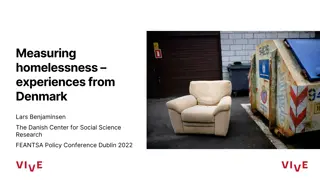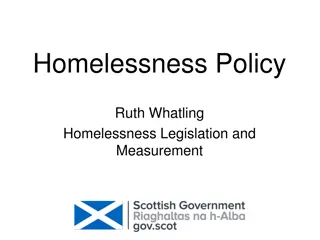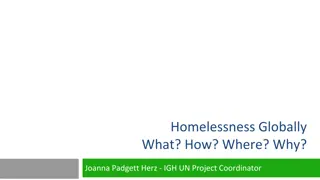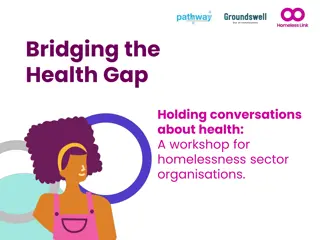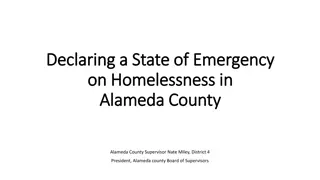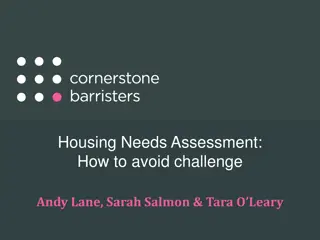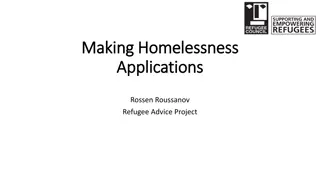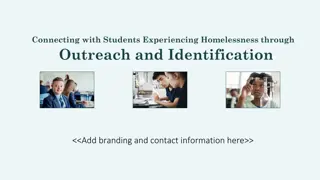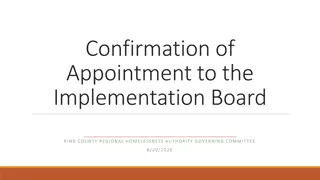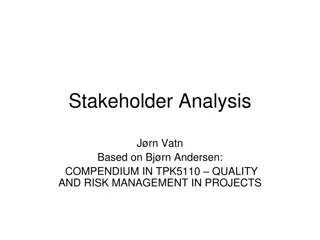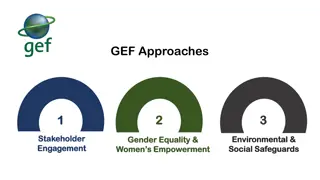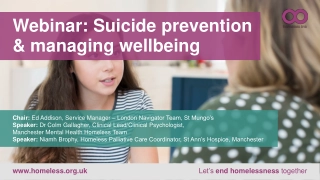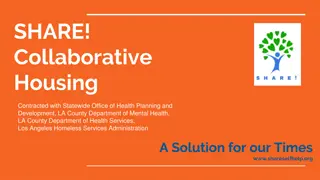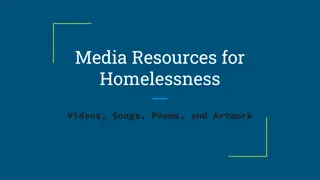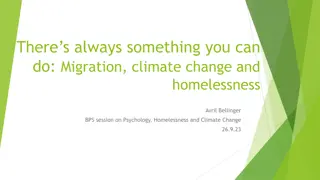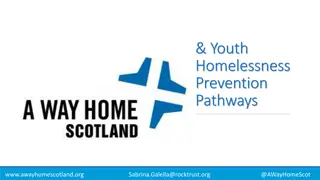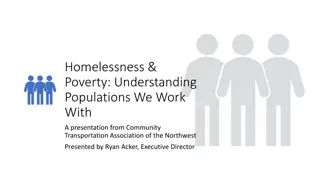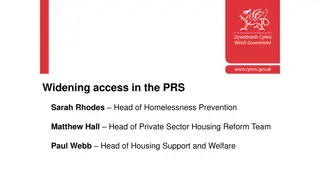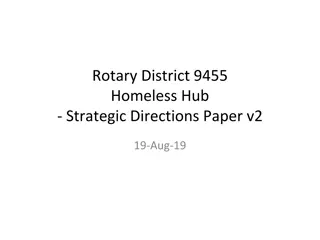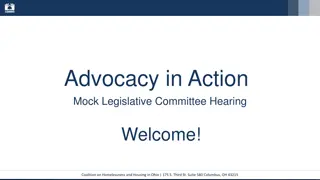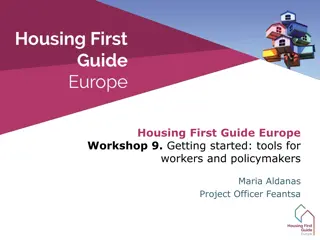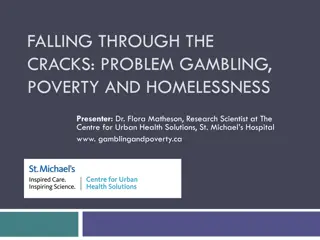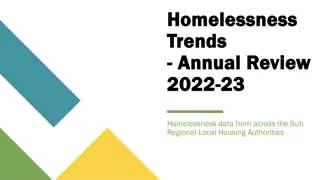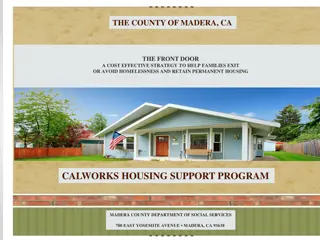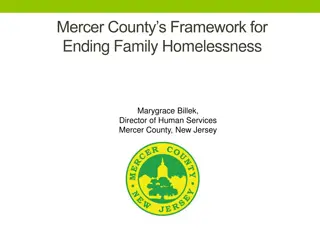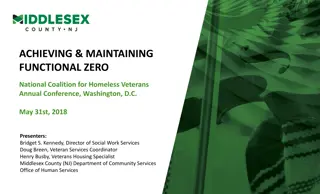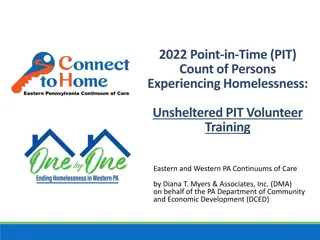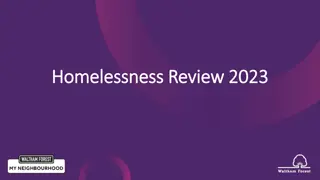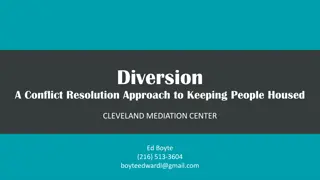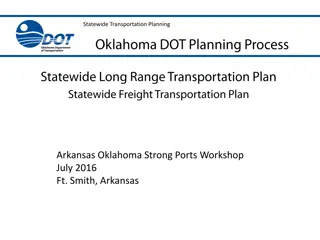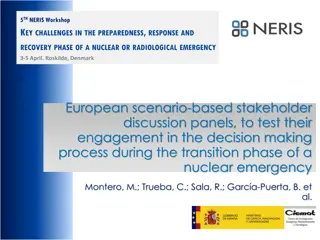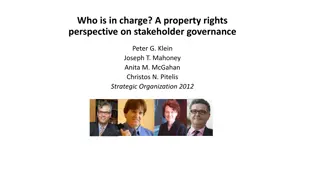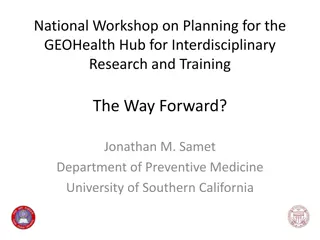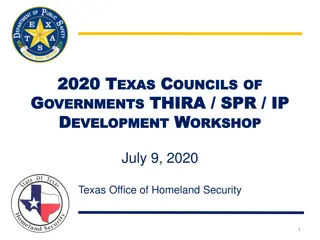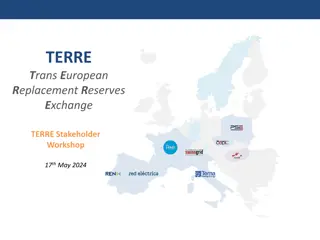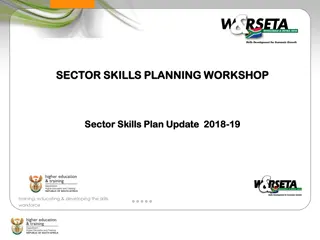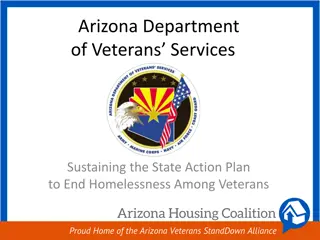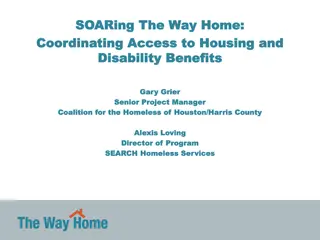Stakeholder Workshop on Homelessness Planning - July 20, 2017
A stakeholder workshop on addressing homelessness challenges, including preventing, responding to, and recovering settled accommodation. The focus is on strategic commissioning to develop recommendations for better service funding and delivery in response to rising homelessness rates across various forms. Causes of homelessness, such as welfare reforms and housing cost trends, are explored, along with the need to tackle rough sleeping and implement effective plans to support individuals at risk.
Download Presentation

Please find below an Image/Link to download the presentation.
The content on the website is provided AS IS for your information and personal use only. It may not be sold, licensed, or shared on other websites without obtaining consent from the author. Download presentation by click this link. If you encounter any issues during the download, it is possible that the publisher has removed the file from their server.
E N D
Presentation Transcript
Focus on Homelessness Planning our Help: Stakeholder Workshop 20thJuly 2017
Agenda 9:45am Recap scene setting, pressures and work underway 9:55am Workshop 1: Preventing Homelessness 10:30am BREAK 10:45am Workshop 2: Responding to Homelessness 11:30am Workshop 3: Recovering Settled Accommodation 12:10pm Councillor Jane Urquhart, NCC 12:15pm Next steps and close
Social Inclusion (Homelessness) Strategic Commissioning Review Purpose to develop recommendations for how services will be funded, planned and delivered in the future Account for changes (need / demand, legislation, funding pressures, innovations) and ensure resources are being put to best use Wider context how the City works to respond to homelessness
Homelessness in all its forms is on the rise across the country statutory acceptances are up 44% (09/10 to 15/16) placements in temporary accommodation are up 52% (10/11 to 15/16) use of bed and breakfast is up 250% since 2009 rough sleeping is up 132% since 2010 Source: Crisis
Causes? Welfare reforms, economic trends and rising housing costs (freeze on LHA, benefit cap, Universal Credit, scrapping housing allowance for u21s) squeezed incomes for poorest Reduced availability of social housing (1% rent reduction, Right to Buy) and more households accommodated in less secure private rented sector Loss of preventative support austerity and end of Supporting People (LA cuts of 67% since 2010)
What do we need to respond to? Rough sleeping up from less than 5 in 2010 to 35 in 2016 (CLG returns)
What does our plan need to respond to? Rough sleeping fewer than 5 per night in 2010 to 35 in 2016 (CLG returns) Risks to people sleeping rough Commitments to No Second Night Out Unbudgeted spend of 100k in 16/17 on support during winter
What do we need to respond to? Rough sleeping fewer than 5 per night in 2010 to 35 in 2016 (CLG returns) Risks to people sleeping rough Commitments to No Second Night Out Unbudgeted spend of 100k in 16/17 on support during winter Bed and breakfast 117 households (May 2017)
Use of bed and breakfast and average cost per placement 900 804 800 Placements 721 700 600 Average cost per placement 500 400 346 337 317 300 200 100 58 0 2014-15 2015-16 2016-17
What does our plan need to respond to? Rough sleeping fewer than 5 per night in 2010 to 35 in 2016 (CLG returns) Risks to people sleeping rough Commitments to No Second Night Out 100k in 16/17 on support during winter Bed and breakfast 117 households (May 2017)
What does our plan need to respond to? Rough sleeping fewer than 5 per night in 2010 to 35 in 2016 (CLG returns) Risks to people sleeping rough Commitments to No Second Night Out 100k in 16/17 on support during winter Bed and breakfast 117 households (May 2017) Mostly families Suitability of response (environment, support, duration of stay, location) Serious and unbudgeted expenditure
What do we need to respond to? Funding pressures / challenges Current HRS spend of c 4.3m pa savings of 445k pa needed from 2018/19 Risks associated with other losses of funding (e.g. preventative support, VCS, etc) Uncertainties through proposed changes to funding of supported housing (devolved HB top ups )
What do we need to respond to? Funding pressures / challenges Current HRS spend of c 4.3m pa savings of 445k pa needed from 2018/19 Risks associated with other losses of funding (e.g. preventative support, VCS, etc) Uncertainties through proposed changes to funding of supported housing (devolved HB top ups ) Mental ill health High proportion of people with mental health needs amongst homeless in City Mental health support not meeting needs
What do we need to respond to? Access to / stability of settled housing
Homelessness caused by tenancy breakdown (national) (assured shorthold tenancy)
What do we need to respond to? Access to / stability of settled housing Significant increase in breakdown of tenancies as cause of homelessness Increased reliance on less secure PRS to resolve homelessness Further demand pressures Welfare Reform, roll out of Universal Credit
What do we need to respond to? Homelessness Reduction Act Duty to provide advisory services specifically to meet the needs of certain groups Duty to work with all households to prevent homelessness within 56 days Duty to prepare a plan of action for prevention Duty to help to relieve homeless for all households for 56 days Expected to come into force in 2018 Extra funding (two years only) for new burdens
What do we need to respond to? Access to settled homes Reactive B&B use and spend Rough Sleeping Mental health needs Supported accom funding changes Lack of security in PRS H less Reduction Act Funding pressures & 445k pa HRS saving Welfare reforms & other drivers of need
What do we need to respond to? Access to settled homes Reactive B&B use and spend Rough Sleeping Mental health needs Supported accom funding changes Lack of security in PRS H less Reduction Act Funding pressures & 445k pa HRS saving Welfare reforms & other drivers of need
Workshops Mix of people in room let s hear all feedback 3 areas prevention, response, sustainment Listen to us talk about the things we re focusing on and the ideas for how we might respond Highlight benefits and pitfalls of different ideas put forward & shape / propose alternatives Help us to put forward the best approachesto respond to the issues we face
Prevention Nancy Cordy Commissioning Manager
Prevention is key Last year ILS services (services that provide advice to help people to avoid homelessness) worked with 2,125 different households. Homelessness prevention service 1,281 6-9 months Crisis service Service for families 432 412 4 weeks 2 weeks 12 months In high demand services have waiting lists BUT feedback that support wasn t available for long enough.
Prevention is far more effective than cure Strong stakeholder support for prevention: It costs us less It s more successful at meeting peoples needs
Too many people miss out on support from services People told us: Criteria were too restrictive Thresholds were too high BUT with limited resources do we need to be more targeted?
Spend to save Currently almost 25% of the HRS homelessness budget is spent on preventative services. Q) Do we need to shift this and how?
The Homelessness Reduction Act should help to improve the prevention of homelessness Aim: More prevention activity which has more chance of working Free info & advice for all Duty to refer Definition of threatened with homelessness 56 days from 28 days Assessment & Personalised Housing Plan
Anyone can end up homeless Young People care leavers Mental Health People leaving hospital People released from prison Victims of domestic abuse NRPF Survivors of modern slavery Priority Families
Encourage services to work closer together The risks: Pushed from pillar to post Duplication Missed opportunities to identify early indicators The options: Identified pathways Co-location Co-ordination Joint assessments
Early intervention by housing advice services 993 citizens support 64,487.40 claimed in benefits 97,712 in debt addressed 217 citizens avoided homelessness Private tenants
Families struggle to manage on the little that they have Government welfare policy is the main reason people are at risk of homelessness Universal credit is a big problem Option: Co-ordinated and targeted approach to preparing people for Universal Credit what does this look like?
People in the private rented sector are vulnerable
PRS gives no stability to people Accessibility Affordability Quality Stability Option: Replicating the support tenants in social housing can access for those in the PRS.
Options - prevention Protect spending on prevention Improve the way services work together Focus preventative activity around individual plans for prevention developed at Housing Aid (required for anyone at risk within 56 days under the new Homelessness Reduction Act) tighten focus on tenancy sustainment Focus on homeless families particularly those: - In the private rented sector - Affected by Universal Credit
Questions Which ideas should we carry forward, and which need a rethink? What do we need to keep in mind in developing the ideas you support? Have we focused on the right areas? What s missing? You have around 25 minutes
Workshop 2: Responding to Homelessness
Whats covered? Assistance for people who have no accommodation available no opportunity for prevention Includes assistance for singles and families Access to accommodation with or without support Assistance for rough sleepers
Rough sleeping Rough Sleepers Enablement Service (SOT) 215k pa No Second Night Out (NSNO) 50k pa Winter Measures 100k in 16/17 Funding in 17/18 TBC Winter Shelter (not funded)
Rough sleeping findings Increase in number of people found sleeping rough from fewer than 5 to 35 from 2010-16 Local connection Less than 40% from Nottingham City Major issues in supporting people without recourse to public funds (refugees and migrants) approx 15% Similarly challenges in supporting people without local connection approx 25% from Nottinghamshire Reconnections happening (50 in 16/17) but on voluntary basis only
Rough sleeping findings (contd) Those with local connection have complex needs exclusion, substance misuse not just about housing Overlap with begging relatively small (15%) but may be a cause Support for outreach activity in the City in feedback one of the best Challenges in access to supported accommodation Support for winter shelter / measures 193 individuals accommodated, 116 positive outcomes (6,000 spaces used) winter shelter is invaluable
Rough sleeping options / proposals 1. Tender for further delivery of outreach support for rough sleepers maintain services 2. Commission / contract for winter measures on a longer term basis but maintain diversity 3. Create opportunity for person centred housing and support solutions through commissioning of supported accommodation 4. Seek to develop wider partnership strategy for rough sleeping to include enforcement and substance misuse treatment
Accommodation and support Singles Total of 10 supported accommodation services (for homelessness) commissioned in the City with HRS funding providing 334 beds per night Direct access 129 beds Specialist 2ndstage 205 beds
Overview of services - Direct access Homelessness Prevention Gateway London Road 55 beds Single Adults GH House 15 beds Single Adults Pelham Avenue 10 beds Single Adults New Albion 24 beds Single Adults 40 Forest Road W 15 beds Single Adults Total bed spaces: 129 HRS spending on Direct Access: 1.2m
Overview of services - Second stage Corporation Oaks 12 beds Young people Ozanam House 13 bed Young people - Female only Young People s Accommodation Service 41 beds Men s Complex Needs 23 beds Male only Colville Complex Needs 23 beds Female only Bentinck Road and MV House 38 beds Drug & Alcohol Offenders Accommodation 55 beds Total bed spaces: 205 HRS spending on second stage: 1.6m



